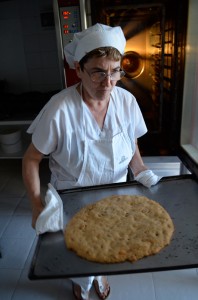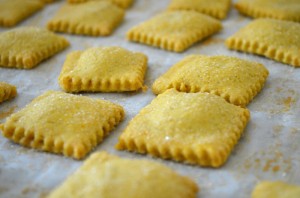Daniela Storoni keeps Renaissance cuisine alive in The Marche
URBINO, Italy — The small square morsel reaches your lips with the aroma of sweet honey and almonds, and with the first bite of the chewy treat your mouth floods with flavors. But as the tastes awaken your pallet, something feels old and familiar, as if history calls you back one bite at a time.
That’s exactly what Daniela Storoni intended with her Rinascimento a Tavola, a line of packaged treats and meats offering consumers a rare glimpse into the lost art of Renaissance cooking. Her label can be found in specialty stores across the Marche.
Storoni, who jokes that she has been cooking since birth, actually stumbled into a career in cuisine en route to a degree in Renaissance art. It happened when she began searching to see how the artistic and intellectual awakening of the time impacted the daily life of the time. She quickly discovered in the Marche the Renaissance was not limited to paintings and sculptures, but reached even into the cuisine of the era.

Marina Cangiotti removes the Mostazzoli from the oven so that it can be sliced and packaged for the store shelves.
“The idea was to see how in the daily life, in the banquets, this rebirth, this philosophical concept of the Renaissance, could somehow be transported in what was the banquet at a glance,” she said.
Urbino was one of the capitol cities of the Italian Renaissance, a place where the duke and his court would surround themselves with the greatest art, music, and rare spice to show off his power.
Storoni explains that the art of cooking and feasting originated in Italy and spread quickly throughout Europe. The banquets hosted by the nobility were not only about the food but about the people and the politics. Over the banquet tables, alliances were forged and demolished, often with bloody consequences. Party planners chose the menus, the decorations, the entertainment, hired the cooks, all to the taste and fashion dictated by the nobility.
So in a time of artistic and intellectual enlightenment, food was as much of an art as the paintings hanging on the walls.
The long banquet tables would overflow with exquisite meals. Two courses were served: a cold meal and a hot meal. In an effort to build something new, ingredients would be cooked separately, then combined with the meats. The meals would start with biscuits soaked in sweet sauces, salads, toscanelle, meatballs and cheeses, cheeses with melon, boiled meat sauce, lemon sauce, and vinegar and bread.
[pullquote]I want to let my customers experience the fantasy of the renaissance.[/pullquote]
The hot dishes would have delicacies such as beef stew, roast veal, venison and pheasants among others.
The foods that most people associate with Italy, like pasta had yet to be created because ingredients like tomatoes, corn, and turkey would not be available until Christopher Columbus returned from the New World.
Certain occasions, like weddings and religious ceremonies, called for certain dishes. Spiumini, a tart made with egg white and lemon zest flavoring, would be served in the houses of the lords for religious events. Noblemen would eat with their hands, however, the Italian nobility were some of the first people to practice washing hands before eating.
It’s the stories and art of these feasts that has inspired Daniela to give new life to renaissance cuisine. She has devoted most of her life to researching renaissance cooking and customs, often using some of the earliest printed cookbooks that were given to the nobility at the time as gifts.
The research helped Storoni bring an ancient menu into the modern kitchen. She created a line of products that center on recipes found in the notes of renaissance cooks. So treats such as cherry-filled biscotti, wheat, sugar and honey cookies and spicy salami all proudly wear the Rinascimento a Tavola label.
Storoni’s line offers customers a chance to sample the food that fueled the Renaissance. Following historical cookbooks, she uses organic, natural ingredients that resurrect the rich, sweet flavors that first put Italian cooking on the map .
She admits, that many people are afraid to try the scrumptious treats. It is hard to find the balance between the palates from500 years ago and those used to today’s drive-thru menus.
People are not accustomed to the rich, spicy flavors that were so prevalent at that time. “I want to let my customers experience the fantasy of the renaissance.”
Multimedia
